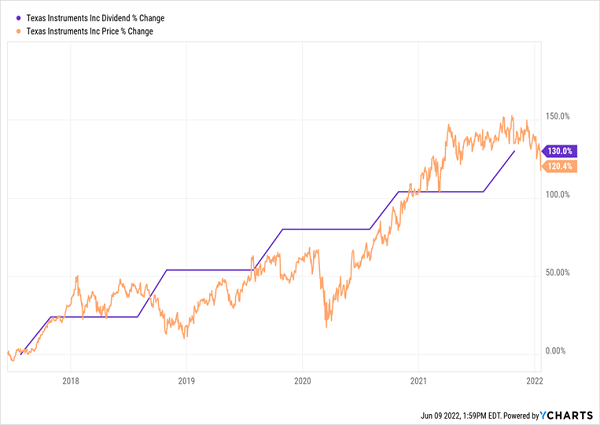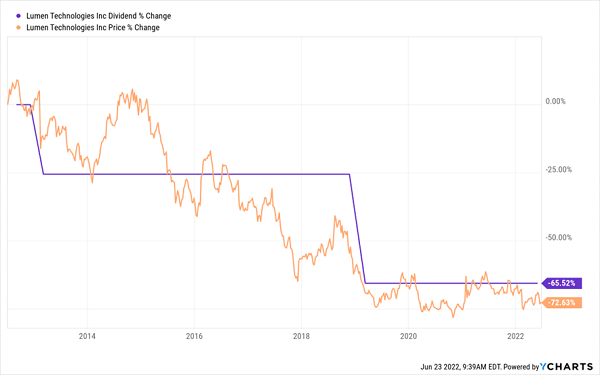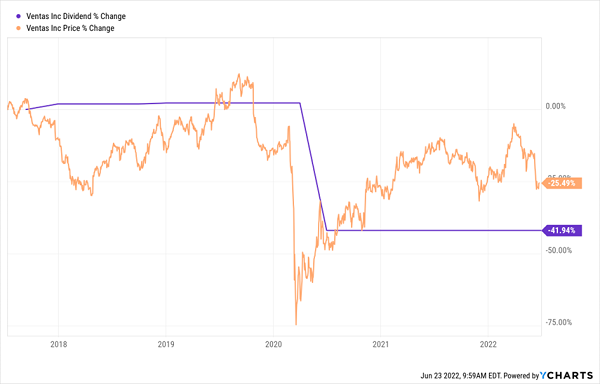Most investors ignore the “magnetic” connection between dividends and share prices. It’s causing them to miss out on huge gains—and setting them up for big losses, too.
Here’s what I mean: in my earlier article in our ongoing series on my “Dividend Magnet” approach to investing, I gave you example after example of how a rising dividend almost inevitably drags a company’s share price up with it.
This is one of the main reasons why we demand a dividend that’s not only growing but accelerating in my Hidden Yields dividend-growth service.
It’s clear as a bell in the chart of Texas Instruments (TXN), below, one of the examples we discussed in our previous article. The stock delivered us big “dividend-powered” returns, with the price and dividend rising in tandem, beat for beat:
TXN’s Dividend Magnet Fires Up

Many folks are surprised when I show them charts like this. But it’s pretty intuitive when you think about it. Have you noticed, for example, that the current yield on some of your favorite stocks usually stays roughly the same, even after they hike their dividends?
That’s because the higher payout attracts investors, who then bid the share price up, and with it the yield back down to its “regular” level (because yields tend to move in opposition to prices). It’s the Dividend Magnet operating in real time!
How My Dividend Magnet Can Help Us Dodge Dividend Cuts
It’s shocking how overlooked this strategy is. One of the best parts is that it’s not just a recipe for price upside. We can use it to protect ourselves from dividend cuts, too. Because just as rising dividends pull share prices up, falling payouts act like a lead weight on a stock.
And if we look for the tell-tale signs of a weak dividend (more on those below), we can use this strategy to oust these stocks from our portfolios before they do major damage. This “dividend safety check” is critically important in this skittish market, where investors are already on the hunt for any reason to hit the sell button.
Examples of how a falling dividend takes out a stock’s price are easy to turn up. You can see it in the stock of regional telecom operator Lumen Technologies (LUMN), a dividend pretender if there ever was one.
(This stock is so prone to cuts that I included it in my Special Investor Report “Behind the 8-Ball: Eight Popular Dividends Set for a Cut,” which you get with a 60-day trial to Hidden Yields. I’ll give you my full dividend-growth strategy and a chance to get yours right here.)
Pity the poor soul who bought this stock a decade ago, when it was yielding a seductive 7.3%. Since then, the payout has been slashed twice, for a 65% reduction in all:
Lumen’s Payout Dives, Dragging Its Share Price With It

This, by the way, is the trap investors risk falling into when they see a high dividend and buy based solely on that. We can see the same pattern with senior-care operator Ventas (VTR), which slashed its dividend when COVID-19 hit, simultaneously taking out the share price:
Ventas: Dividend Down, Share Price Down

Sure, we can forgive the company for slashing its payout when the virus arrived. But it had been giving off signals that a cut was coming long beforehand. See how the payout slowed down and then went flat in the chart above?
That’s a clear “tell” that a cut was in the offing. An investor who sold at that point would have sidestepped it, and the big drop in the share price, too.
This Measure Can Give You a “Dividend Early Warning Signal”
But we can do even better, potentially front-running even a dividend slowdown with another of my favorite “dividend safety indicators,” a company’s free cash flow (FCF) payout ratio.
It’s essentially a measure of the amount of money a company has paid out in dividends over the last 12 months as a percentage of its FCF, which is a reliable snapshot of the amount of cash flow it’s generating. (I prefer FCF to earnings per share because EPS can be more easily manipulated.)
For the FCF payout ratio, I demand a level below 50% for maximum safety. For real estate investment trusts (REITs), which use funds from operations (FFO) as their main profitability measure, we can accept ratios up to 90%, as REITs get predictable rent checks from their tenants.
This Dividend “Sacred Cow” Could Be Next to Chop Its Payout
With this in mind, Kimberly-Clark (KMB) is a stock we definitely want to avoid now. First up, the dividend, which might seem attractive, with its 3.6% yield. But this “high” yield is hiding something: slowing payout growth!
Kimberly-Clark’s Dividend Slows—A Cut in the Cards?

Finally, KMB’s FCF payout ratio is way too high at 93%, and it threatens to keep rising as soaring material costs weigh on the company’s results.
My take? Don’t buy the “wisdom” that a maker of consumer staples like KMB is “safe.” With inflation likely to stick around, its dividend is bound to come under more pressure. And because it’s mainly held by conservative investors, they’ll quickly sell on a dividend cut, powering up the “reverse Dividend Magnet” and crushing the share price, too.
(This is the third article in our series on my Dividend Magnet approach to investing. In our next article, we’ll look at how dividend growth combines with another wildly misunderstood way that companies “pay” us—stock buybacks, to send returns higher.)
7 Buys for Accelerating Dividends (Through Inflation and Recession)
My “Dividend Magnet” approach is the driving force behind the steady double-digit gains I’m forecasting from the 7 stocks I want to tell you about right here.
All 7 boast dividends that are rising sharply, and I expect those rising payouts to drag these companies’ share prices higher for years and years to come. Your projected return? 15% a year from these 7 stout dividend growers, on an annualized basis.
These reliable dividend growers are the antidote to today’s depressed market, transitioning as it is between inflation and a potential recession. Their rising payouts, which support their share prices, act as a buffer against this uncertainty—and a source of rising income for you.
Don’t miss your chance to buy these 7 stout dividend growers while they’re still bargains. Click here and I’ll reveal all the details of my Dividend Magnet approach and give you access to these 7 “battleship” dividend growers in an exclusive investor report.

Recent Comments